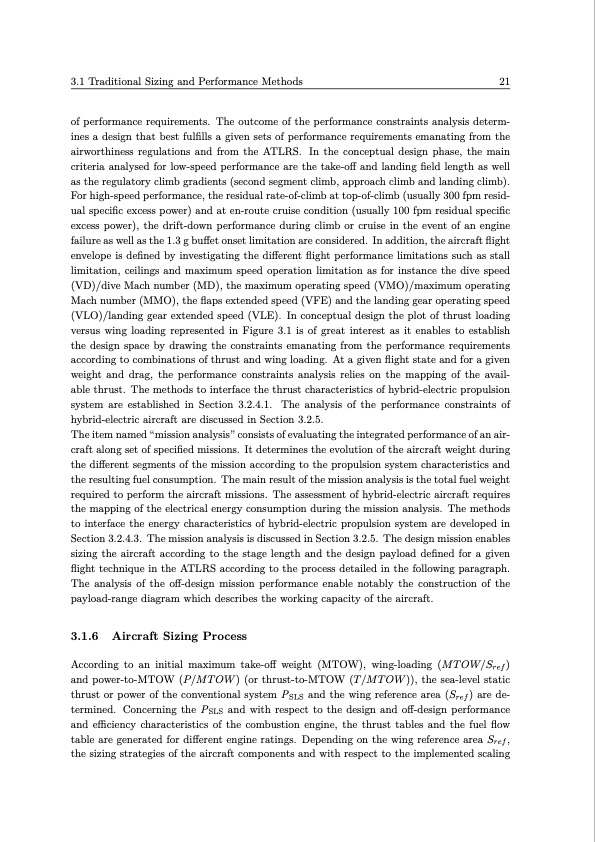
PDF Publication Title:
Text from PDF Page: 043
3.1 Traditional Sizing and Performance Methods 21 of performance requirements. The outcome of the performance constraints analysis determ- ines a design that best fulfills a given sets of performance requirements emanating from the airworthiness regulations and from the ATLRS. In the conceptual design phase, the main criteria analysed for low-speed performance are the take-off and landing field length as well as the regulatory climb gradients (second segment climb, approach climb and landing climb). For high-speed performance, the residual rate-of-climb at top-of-climb (usually 300 fpm resid- ual specific excess power) and at en-route cruise condition (usually 100 fpm residual specific excess power), the drift-down performance during climb or cruise in the event of an engine failure as well as the 1.3 g buffet onset limitation are considered. In addition, the aircraft flight envelope is defined by investigating the different flight performance limitations such as stall limitation, ceilings and maximum speed operation limitation as for instance the dive speed (VD)/dive Mach number (MD), the maximum operating speed (VMO)/maximum operating Mach number (MMO), the flaps extended speed (VFE) and the landing gear operating speed (VLO)/landing gear extended speed (VLE). In conceptual design the plot of thrust loading versus wing loading represented in Figure 3.1 is of great interest as it enables to establish the design space by drawing the constraints emanating from the performance requirements according to combinations of thrust and wing loading. At a given flight state and for a given weight and drag, the performance constraints analysis relies on the mapping of the avail- able thrust. The methods to interface the thrust characteristics of hybrid-electric propulsion system are established in Section 3.2.4.1. The analysis of the performance constraints of hybrid-electric aircraft are discussed in Section 3.2.5. The item named “mission analysis” consists of evaluating the integrated performance of an air- craft along set of specified missions. It determines the evolution of the aircraft weight during the different segments of the mission according to the propulsion system characteristics and the resulting fuel consumption. The main result of the mission analysis is the total fuel weight required to perform the aircraft missions. The assessment of hybrid-electric aircraft requires the mapping of the electrical energy consumption during the mission analysis. The methods to interface the energy characteristics of hybrid-electric propulsion system are developed in Section 3.2.4.3. The mission analysis is discussed in Section 3.2.5. The design mission enables sizing the aircraft according to the stage length and the design payload defined for a given flight technique in the ATLRS according to the process detailed in the following paragraph. The analysis of the off-design mission performance enable notably the construction of the payload-range diagram which describes the working capacity of the aircraft. 3.1.6 Aircraft Sizing Process According to an initial maximum take-off weight (MTOW), wing-loading (𝑀𝑇𝑂𝑊/𝑆𝑟𝑒𝑓) and power-to-MTOW (𝑃/𝑀𝑇𝑂𝑊) (or thrust-to-MTOW (𝑇/𝑀𝑇𝑂𝑊)), the sea-level static thrust or power of the conventional system PSLS and the wing reference area (𝑆𝑟𝑒𝑓) are de- termined. Concerning the PSLS and with respect to the design and off-design performance and efficiency characteristics of the combustion engine, the thrust tables and the fuel flow table are generated for different engine ratings. Depending on the wing reference area 𝑆𝑟𝑒𝑓 , the sizing strategies of the aircraft components and with respect to the implemented scalingPDF Image | Conceptual Design Methods Hybrid-Electric Transport Aircraft

PDF Search Title:
Conceptual Design Methods Hybrid-Electric Transport AircraftOriginal File Name Searched:
1399547.pdfDIY PDF Search: Google It | Yahoo | Bing
NFT (Non Fungible Token): Buy our tech, design, development or system NFT and become part of our tech NFT network... More Info
IT XR Project Redstone NFT Available for Sale: NFT for high tech turbine design with one part 3D printed counter-rotating energy turbine. Be part of the future with this NFT. Can be bought and sold but only one design NFT exists. Royalties go to the developer (Infinity) to keep enhancing design and applications... More Info
Infinity Turbine IT XR Project Redstone Design: NFT for sale... NFT for high tech turbine design with one part 3D printed counter-rotating energy turbine. Includes all rights to this turbine design, including license for Fluid Handling Block I and II for the turbine assembly and housing. The NFT includes the blueprints (cad/cam), revenue streams, and all future development of the IT XR Project Redstone... More Info
Infinity Turbine ROT Radial Outflow Turbine 24 Design and Worldwide Rights: NFT for sale... NFT for the ROT 24 energy turbine. Be part of the future with this NFT. This design can be bought and sold but only one design NFT exists. You may manufacture the unit, or get the revenues from its sale from Infinity Turbine. Royalties go to the developer (Infinity) to keep enhancing design and applications... More Info
Infinity Supercritical CO2 10 Liter Extractor Design and Worldwide Rights: The Infinity Supercritical 10L CO2 extractor is for botanical oil extraction, which is rich in terpenes and can produce shelf ready full spectrum oil. With over 5 years of development, this industry leader mature extractor machine has been sold since 2015 and is part of many profitable businesses. The process can also be used for electrowinning, e-waste recycling, and lithium battery recycling, gold mining electronic wastes, precious metals. CO2 can also be used in a reverse fuel cell with nafion to make a gas-to-liquids fuel, such as methanol, ethanol and butanol or ethylene. Supercritical CO2 has also been used for treating nafion to make it more effective catalyst. This NFT is for the purchase of worldwide rights which includes the design. More Info
NFT (Non Fungible Token): Buy our tech, design, development or system NFT and become part of our tech NFT network... More Info
Infinity Turbine Products: Special for this month, any plans are $10,000 for complete Cad/Cam blueprints. License is for one build. Try before you buy a production license. May pay by Bitcoin or other Crypto. Products Page... More Info
| CONTACT TEL: 608-238-6001 Email: greg@infinityturbine.com | RSS | AMP |